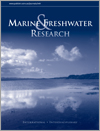Marine and Freshwater Research
Volume 74
Number 7 2023
This study investigated the behavioural and physiological responses of little penguins to experimental playback of construction noises. Little penguins spent significantly more time in vigilance (but showed no increased in heart rate) during the construction noise playback than they did during the control. Our results suggest that extended exposure to construction noises may reduce the time individuals spend performing biologically important behaviours.
This study examined two aspects of the reproductive biology of sawsharks: multiple paternity and hybridisation. Analysis of the nuclear DNA of pups from the common (Pristiophorus cirratus) and southern (Pristiphorus nudipinnis) sawsharks showed that a single litter can be fathered by multiple males. Nuclear DNA analysis also showed that these two sawshark species can produce hybrids. One adult individual initially identified as P. nudipinnis, but possessing the mitochondrial DNA of P. cirratus, had nuclear DNA characteristic of both species.
This study assessed nutrient variations in coral, coral symbionts and algae in relation to depth using nitrogen (δ15N) and carbon (δ13C) stable isotope analysis. Depth was associated with a decrease in symbiont density and δ13C in macroalgae. δ15N did not change with depth for corals, symbionts or macroalgae. We propose that the symbionts may be compensating for nutrient changes associated with depth to satisfy the coral–host requirements.
River fragmentation threatens Indo-Pacific anguillid eels, which are ecologically and commercially important species. The free-flowing large river, the Nu–Salween River, may be their last remaining habitat. We adopted an integrative taxonomy to successfully identify three eel species collected in the upper reach from 2017 to 2021. A. bengalensis has the widest distribution range, whereas A. bicolor and A. marmorata have narrower ranges, but are new to this area. Climate change and anthropogenic disruptions may have caused the three eels to expand upstream.
Yellowfin (Acanthopagrus australis) and black bream (Acanthopagrus butcheri) can hybridise in south-eastern Australia. By understanding the movements of these bream species and their hybrids we can better determine factors that may lead to changes in the amount of hybridisation that occurs. This study found that overlap in distribution of yellowfin bream and bream species hybrids occurs that may facilitate genetic mixing between species.
Freshwater plants can accumulate microplastics, which, as they form the base of food webs, has implications for higher trophic levels. This study compares the ability of freshwater plants with different leaf shapes to trap downwelling microplastics. Results suggest that leaf shape complexity is associated with microplastic entrapment―findings that have potential applications in bioremediation and biomonitoring of plastic pollution.





